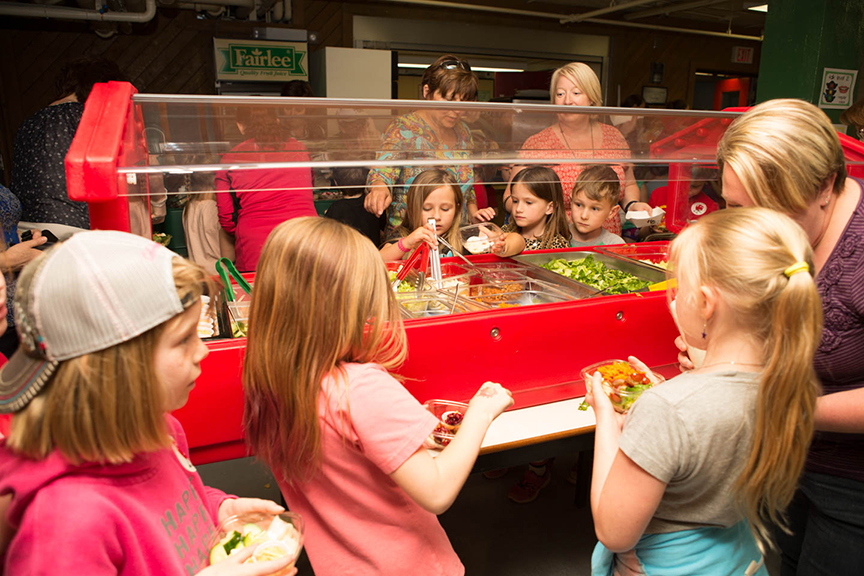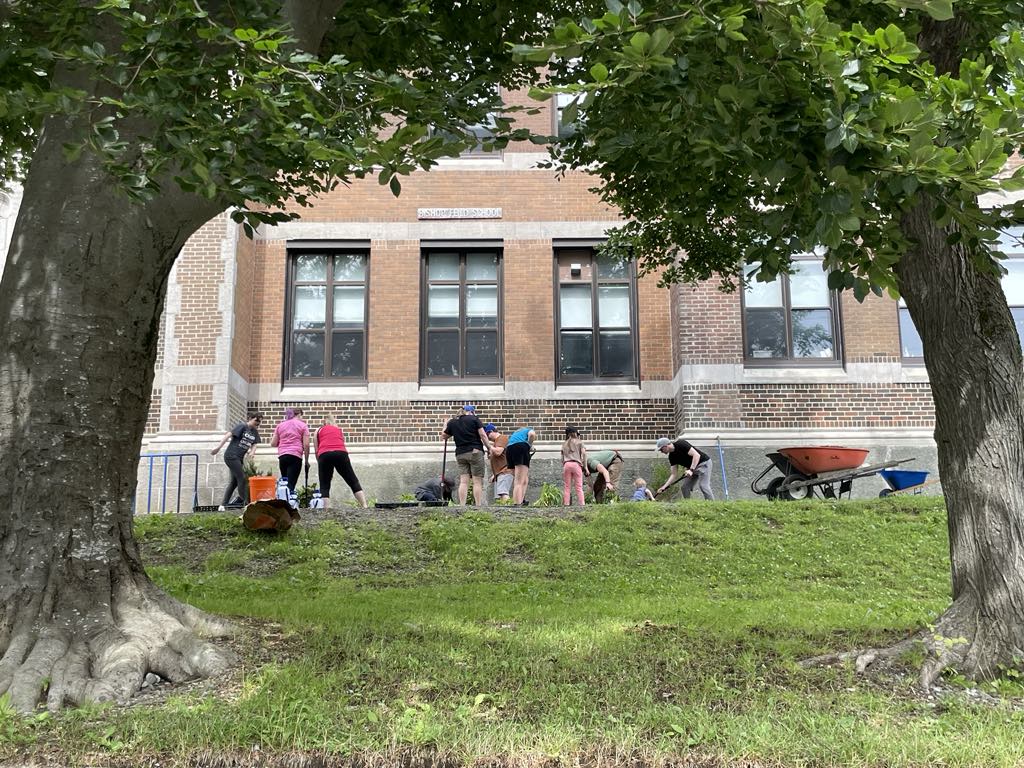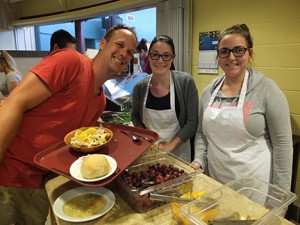
Salad bars in schools. An oxymoron? Not in the US where the 4000th school salad bar was granted earlier this year. As part of Michelle Obama’s Let’s Move campaign, over $10 million in salad bar equipment and training has been provided to US schools. Farm to Cafeteria Canada (F2CC) is championing the same model in Canada and aims to see a garden, a kitchen, a salad bar, a dining area, and composting in every Canadian school!
“I estimate there are at least 300 salad bar programs in Canada. F2CC is intent on doubling that number in the next few years”, says Joanne Bays, National Manager of Farm to Cafeteria Canada. “We want every student in those schools to have an opportunity to feast at a salad bar filled with fresh foods from nearby farms, fields and waters.”
As a step towards that goal, F2CC has partnered with a number of agencies to secure funds from the Canadian Partners Against Cancer in order to implement the Nourishing School Communities Initiative. Growing Farm to School salad bars in Atlantic Canada is a big part of that initiative! This spring, with the support of local farmers, educators, nutritionists, community developers, students and representatives from NGOs – seven new Farm to School Salad Bar programs sprouted in New Brunswick and one in Newfoundland.
A salad bar, particularly one that the students help prepare, offers endless educational and tasting opportunities. At Clement Cormier high school in New Brunswick, carpentry classes renovated the cooking lab, from the floors to the cabinetry. The horticulture classes manage the community garden and planned the installation of a geothermal greenhouse. Lastly, and crucially, the home economics classes prepare the salad bar itself, which is served alongside the cafeteria offerings.
Despite launching their salad bar in the depths of winter – not a favourable time for salads or for local produce variety – their school has seen salad purchases skyrocket from two to three per week from the cafeteria to 80 from the salad bar, even though the salad bar is available only twice per week.
In Elementary schools, students are equally excited to spend time in the kitchen with their friends preparing dishes to serve to their classmates. The grade five students at Centreville Community School concentrate on their tasks of peeling carrots and potatoes and offer up reflections about how hard farmers work. The sense of leadership the students are developing is evident as they proudly manage checklists of orders and responsibly ensure each of the students receives their pre-ordered winter soup and salad.
Most Farm to School salad bars display eight to twelve dishes featuring an enticing variety of colours and flavours that get the students lining up. It’s no different than eating at a buffet; most people want to try a bit of everything when presented with so many options. Evaluation data from a Vancouver school showed that only 7% of students brought both fruits and vegetables in their bagged lunch, but that 80% of students voluntarily choose both fruit and a vegetables when eating at the salad bar.
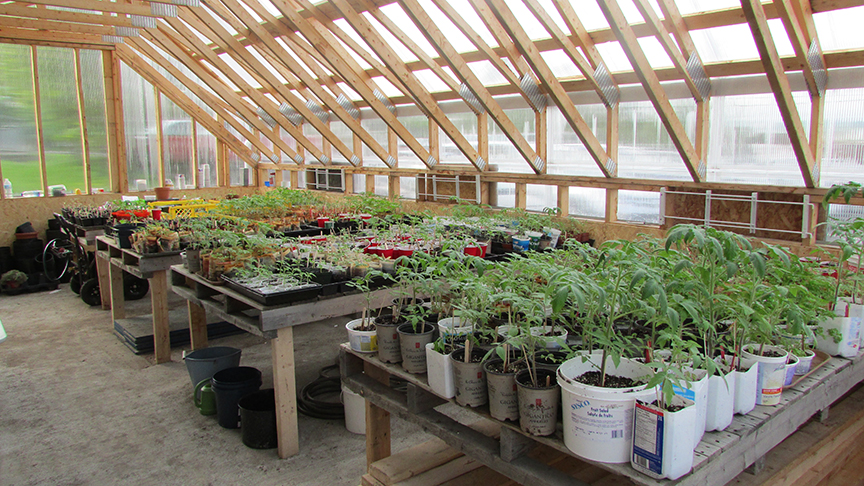
Other than success at the key outcome of getting kids to eat more fruits and veggies, the schools have successfully engaged students in hands on food-based learning. Growing food is the learning activity that most schools tackle first. Even in snowy climates, six out of the seven schools have found ways to demonstrate the challenge and reward of growing food. Some use indoor grow labs, others have built garden beds and greenhouses that they use seasonally. Beyond growing food, students develop skills in cooking, composting, and serving foods.
In this sparsely populated province where everyone seems to know a farmer, many people share the sentiment that all of the schools can and should be part of a movement towards building the local economy by supporting local farmers and feeding kids well. Most people working in food security and food distribution comment on how easy it is to meet with provincial policy makers to speak about school food system ideas and solutions.
Even so, the seven schools still encounter challenges. There is a lack of variety of local vegetables available in the winter, making the launch of their salad bars in the winter all the more difficult. Determining the amount of food to prepare for a self-serve salad bar is an uncertain and unpredictable art, and there can sometimes be high food waste. Other challenges include trying to keep costs low for families, while paying farmers fairly.
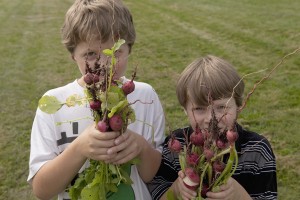
An advantage of having seven schools on a similar trajectory in (relatively) close geographical proximity is information sharing in person to help overcome these challenges. Their second meeting, held recently, led to focused discussions on sustainability, leadership, partnerships, education and communication. It also led to conversations about the importance of procurement policies and food supplier contracts that require local products to be served in schools.
The Anglophone East school district’s recent Request for Proposals for Food Services raised the bar on food procurement. Their progressive RFP encompasses all of the elements of a whole school and community approach to good food, ranging from requirements for local food, healthy food, hands on student learning, food safety, and even a welcoming eating environment.
The rapidity with which New Brunswick schools, farmers, and community partners have transformed school food systems to provide and present healthy, local food to students and staff has impressed people across the country. It wouldn’t be surprising for New Brunswick to be the first province to double their salad bar numbers. The question after that is: ‘which province will be next’?
For more information:
Roxana Atkinson, National Farm to School Liaison & Provincial Coordinator, Farm to School NB, Farm to Cafeteria Canada
farmtoschoolnb@gmail.com
http://www.nbfoodsecurity.ca/
To connect with Farm to School leads in other provinces, visit:
https://www.farmtocafeteriacanada.ca/about-us/regional-leads/ (for the Eng translation)


